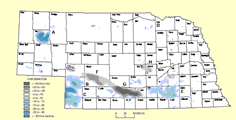Natural Resources, School of
Date of this Version
2018
Citation
Divine, Dana P., Eversoll, Duane A. and Leslie M. Howard. 2018. The Groundwater Atlas of Red Willow County, Nebraska (R.F. Diffendal, Jr., Ed.). University of Nebraska—Lincoln, Conservation and Survey Division, Resource Atlas No. 11, 35p.
Abstract
The purpose of this groundwater atlas is to synthesize a wealth of hydrogeologic data for Red Willow County that has not been published in readily accessible formats previously. Many of the maps presented here are based on geologic information from registered wells and test holes that is publically available on-line, which becomes more valuable when compiled, analyzed, and discussed as a whole.
In Red Willow County, the aquifers are alluvial sand and gravel in the river and stream valleys and the High Plains aquifer beneath the uplands. The High Plains aquifer in Red Willow County consists primarily of the Ogallala Group (about 10 to 2.58 million years old), and some younger saturated Quaternary sand and gravel in places. Elsewhere in Nebraska, the High Plains aquifer may also include the Brule Formation, Arikaree Group, Broadwater Formation, and more saturated Quaternary sand. Thus, even though the High Plains aquifer is present across most of the county, groundwater is not as plentiful as in central Nebraska where the High Plains aquifer includes more geologic units and is thicker.
The Ogallala Group and Quaternary sand and gravel are mantled by wind-blown silt (called loess) across the entire county, except in the valleys. Loess thickness in the county is generally about 100 feet (30.5 meters). The loess can maintain vertical walls and forms steep-walled gullies and canyons in dissected terrain. Some gullies are also eroded into the underlying Ogallala Group. Cretaceous Pierre Shale and Niobrara Formation directly underlie the Ogallala Group. These Cretaceous bedrock units function as relatively small aquifers elsewhere in Nebraska, but not in Red Willow County because the lithology here is mostly shale and is probably less weathered than in the areas functioning as aquifers.
The alluvial and High Plains aquifers in Red Willow County are probably hydrologically connected; as such, this publication maps the two aquifers as one. Groundwater generally moves eastward across the county, although the Republican River gains groundwater and influences the groundwater flow direction in its vicinity. Depth to water varies from zero to about 200 feet (61 m) in most places, but may be up to 250 feet (76 m). Saturated thickness ranges from near zero in some places to slightly more than 120 feet (37 m) along the northern border. The aquifer probably receives an average of about 0.43 inches (10.8 mm) of recharge annually, which is about 2% of precipitation. The water quality is generally good, although elevated levels of anthropogenic nitrate has been reported in places.
This relatively shallow aquifer is the focus of this publication, but there are also deeper units that contain fluids such as oil and brine (very salty water). Red Willow County overlies part of the crest and the western flank of a deeply buried structural feature called the Cambridge arch. The arch formed in granitic basement rock about 470 million years ago, and has been uplifted several times since then. Subaerial erosion and runoff on the arch about 320 million years ago produced a localized sandstone unit that is now buried at a depth of about 3,450 feet (1,052 m). This sandstone unit is the primary pay zone at the Sleepy Hollow oil field, the most productive oil field in Nebraska. Oil is also produced from the Lansing and Kansas City groups, which consist mostly of alternating limestone and shale layers deposited above the sandstone.
Included in
Geology Commons, Geomorphology Commons, Hydrology Commons, Paleontology Commons, Sedimentology Commons, Soil Science Commons, Stratigraphy Commons


Comments
RA-11